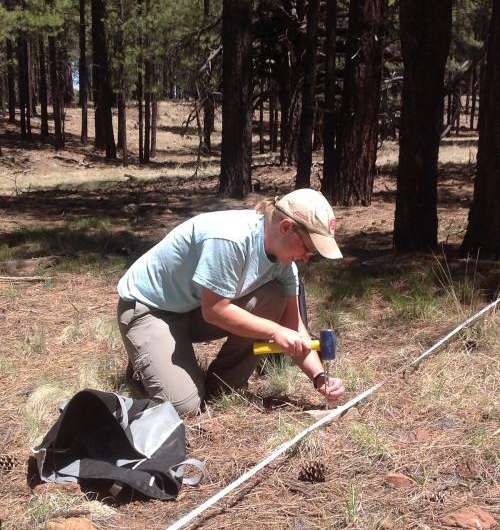Managing water resources in forest restoration

Hundreds of thousands of acres on the Coconino National Forest are slated for thinning during the next 20 years. Two NAU researchers want the forest restoration efforts to result in better water quality and quantity, a shift that could reduce wildfire risk, prevent post-fire flooding and save cities money in water treatment costs.
Sharon Masek Lopez, a watershed restoration research specialist, and post-doctoral scholar Frances O'Donnell, will determine the ideal landscape for supporting forest health. "We want to use our data to make recommendations to people doing the thinning about what kinds of forest treatment intensity and patterns are best for snow and soil moisture," O'Donnell said.
Applying water resource management techniques to forest thinning could reduce risk of catastrophic wildfire. Spacing of trees affects the amount of water that stays on the forest, along with evaporation and wind. "The major source of soil moisture is our winter snow and shade is a huge factor in how long the snow pack remains in forest openings," Masek Lopez said.
Calculated thinning efforts are not expected to significantly increase water flows, but slight improvements can make a substantial difference over time and help trees remain healthy during a prolonged drought.
This research also is important to water users who pay a high price for treatment of water after a wildfire. Following Arizona's Rodeo-Chediski and Sunflower fires, municipalities spent significant funds to remove organic carbon from the water supply.
Masek Lopez and O'Donnell's watershed study areas are west of Flagstaff. At sites where restoration has been performed, Snow water content and soil moisture are measured on sites that have been thinned and compared to water content on unthinned test sites.
Moisture levels are measured by using probes placed in the soil. Snow water content is measured by weighing snow collected in a tube. A method called flowtography uses time-lapse wildlife cameras to gauge water flow in ephemeral channels by taking photos of a marked post every 15 minutes. Overgrown forest plots are compared to areas of treated forest to determine the best tree density for enhancing surface water runoff.
O'Donnell said the research is a pilot study that will determine the best methods for monitoring forest moisture before and after thinning, in a long-term paired watershed study. The science is partially funded by Technology Research Initiatives Funds.
Provided by Northern Arizona University


















